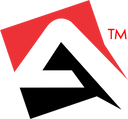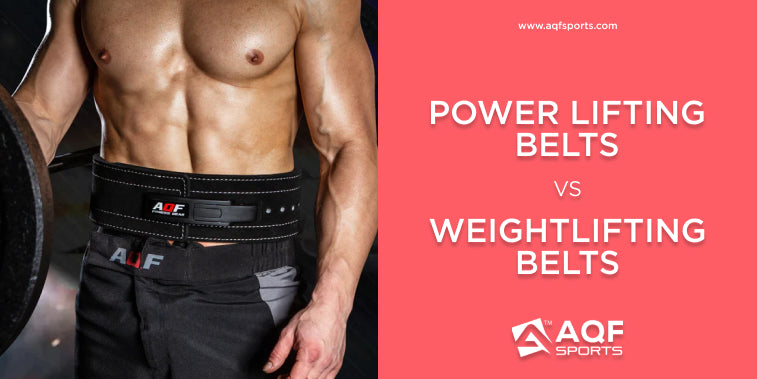
You see powerlifting belts and weightlifting belts all over Instagram and Facebook. Your favourite trainers and celebrities like Henry Cavill and Jack Hughman wear these at the gym. But do you know what factors differentiate them from each other? Let’s find out!
How can you differentiate between weightlifting belts & powerlifting belts? Both look the same for a non-user or a beginner lifter and both are considered super important in all the training hubs and gyms.
Most of the centers provide the equipment on their own to all the trainers and trainees. However, some gyms do not, so you have to buy a belt yourself.
Powerlifting belt and weightlifting belts have gained popularity over time due to their benefits and usefulness. Today a major chunk of the athletes and weightlifters use these belts. From gyms to major sports competitions like the Olympics, they’re virtually everywhere.
But before you go and buy yourself one, it is worth knowing how they differ from one another. We have created this guide to help you with that:
Significant Differences Between Powerlifting vs Weightlifting Belts
Both the belts may look quite similar at the first look, however, there are a few differences depending on the use. Powerlifting belts are used to mainly lift the heaviest of the weights by squatting, deadlifting, or benching, whereas in weightlifting, the process is much faster as you snatch the weight from the ground to overhead and back.
As many people cannot differentiate between powerlifting and weightlifting, these two forms create significant differences in the training process and the exercises performed. So, the belts differ from each other as well. Your choice is going to depend on your requirements, so let’s uncover that mystery and get started:
Material
Let’s get the basic difference out of the way first: a powerlifting belt is usually rigid and a weightlifting belt is flexible.
On one hand, you have powerlifting belts that are mostly made of leather and are non-stretchable. You will also find a few made of vinyl but it’s better to stick to the leather because it is easier to wrap around the body owing to its stiffness.
Since powerlifters lift heavier weights than weightlifters, a rigid belt is better suited to them.
On the other hand, you have weightlifting belts that are mostly made of vinyl. However, there are a few versions that are made of leather as well.
Weightlifting belts are thinner than powerlifting belts which is why they are more flexible and you don’t need a lot of active effort to wrap them around your body.
Buckle Design
Coming to the buckle design, weightlifting belts normally have Velcro straps while powerlifting belts use a buckle that is similar to what you find on your normal belts. Buckles on powerlifting belts vary from a lever mechanism to a prong mechanism.
Now, if you look at powerlifting belts, their buckles are easier to fasten because they are constructed with a prong or lever (as mentioned above). The former is similar to your regular belt buckles.
All you have to do is pull the strap and loop it around and voila! However, a lever buckle works like a clamp system making it more secure than the prong mechanism. Plus, it makes it easier to loosen or tighten the belt.
On the other hand, weightlifting belts have Velcro closures which help the designer of belts keep as little material in front of the body as possible.
The reason why weightlifting belts do not have buckles is that weightlifters need to keep the barbell close to their body when throwing the bar overhead which is not possible if the belt has a big buckle.
While velcro is not as strong or secure as a prong or lever, it ensures that you do not hit your belt with a barbell while lifting.
Design of the Belts
Powerlifting belts have the same width all the way around which is normally around 4 inches. This width remains consistent in order to provide powerlifters equal support throughout their torso. Moreover, powerlifting belts help lifters create 360 degrees of tension around their torso, so they can easily squat and deadlift at the same time.
Weightlifting belts, on the other hand, are tapered in their design. They are normally 46 inches wide in the back and 3-4 inches wide in the front. The reason for the tapered design is to allow the weightlifter to move his hips a bit more freely and attain clean lifting jerks.
Thickness of the Belts
The thickness of your belt, be it a powerlifting belt or a weightlifting belt, can make or break your workout session!
Powerlifting belts range from 10 mm to 13 mm in thickness. The 10 mm thickness is the most commonly available one on the market and it provides enough rigidity to perform a workout without any hindrance.
Similarly, weightlifting belts also vary in their thickness but they never go beyond 11 mm. The most commonly available thickness of weightlifting belts is 5 mm. However, in the case of leather models thickness is not always advertised.
Shield for Back
Weight lifting belts support the back as there are more chances of injuries due to faster lifting. They are made to provide cushioning at the back and are flexible enough to offer safety for the back muscles when the weight is put back down.
Powerlifting belts keep the spine safe and protected by keeping the belt tangled rigidly with the spine. This process creates abdominal pressure and is essential for powerlifters for squats. The stiffness of this belt protects the body from any damage. You can check out some of the best weight lifting belts here.
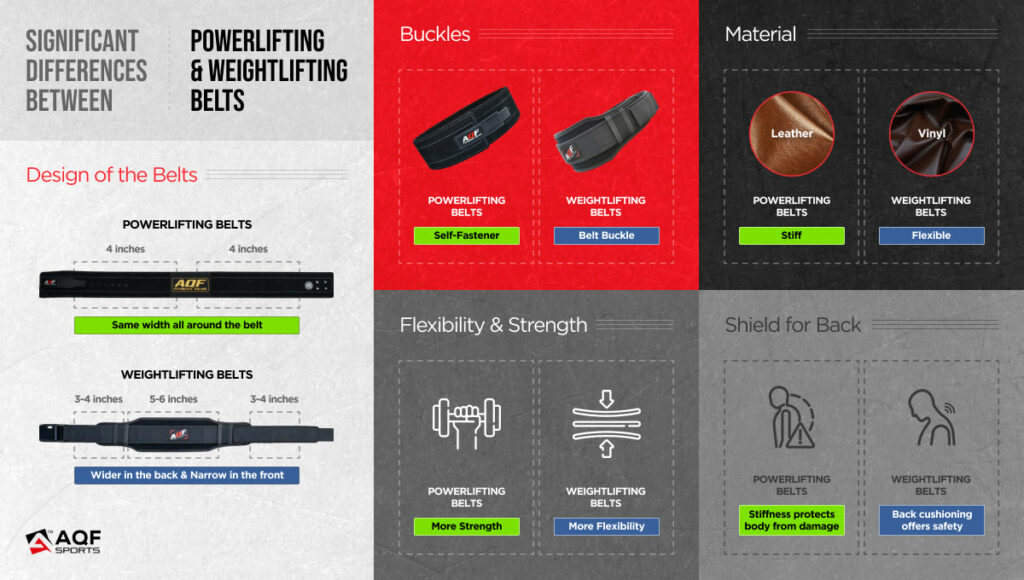
How Do Belts Help in Training?
Belts play a crucial role in aiding your workout routines. A belt is a reminder for you to keep your spine in the correct position. It stabilises the spine during heavy lifting scenarios, providing you with the intra-abdominal pressure you need for a fruitful lifting session.
The use of belts is not limited to just supporting your back and protecting the core muscles. They help put the lower back muscles and abs to use. However, it is still advised to learn the proper techniques and ways to improve your form.
Keep your spine stable, lift with your legs rather than your back. The core exerts pressure while lifting weight, so it is imperative to brace your torso and promote muscle growth. You should consider wearing a belt while heavy lifting if you don’t want to put stress on your back!
Let’s summarise a few benefits of using belts while training:
- They bring out the best in your performance
- Improve the body’s reflex actions, especially when lifting heavier weights
- Reduce the strain on the spine
- Support your torso to keep it from giving away under the weight
- Protect from any injury or damage
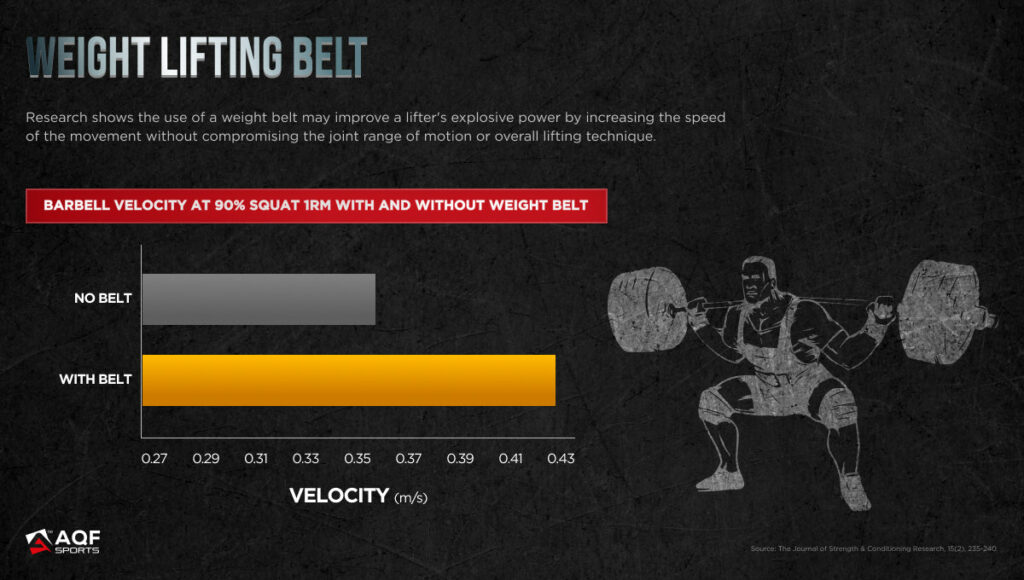
Source: https://pubmed.ncbi.nlm.nih.gov/11710410/
Which is the ‘Right’ One For You?
First, you must know about the type of belt you require for your fitness goals. Are you looking for the one that can help you lift heavy weights or something that’s more like a snatch, clean, and jerk kind of belt?
You can relate the experience of buying a weightlifting belt or powerlifting belt to getting a pair of shoes. Your primary preferences should be:
- Comfort
- Correct fitting
The next thing to look for is support and rigidness; you should opt for a belt with thicker designs for heavy lifting. However, if movement is your main concern, thinner belts would be a better choice for you.
-

AQF Heavy Duty Dipping Belt with Metal Chain
£21.99
Buy Now -

AQF Lever Buckle Leather Powerlifting Belt 10mm
£34.99
Buy Now -
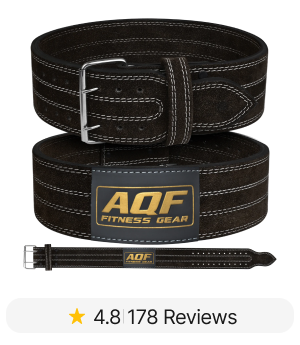
AQF Weight Lifting Nubuck Leather Power Belt
£22.99
Buy Now
TLDR: The choice of the belt depends on the main purpose of buying it.

Conclusion:
Belts are a must-have fitness gear that every athlete or trainee should have for an enhanced and safe training experience. People might think weightlifting or powerlifting belts help lift heavier weights but that is a common misconception. Their principal purpose is to reduce the stress on the spine and provide the necessary support to the lifter’s body.
The right belt will help you enhance your performance. So, learn about their differences if you want to achieve a snatched body without injuring your back!
You may also like to read;
- The Definitive Weightlifting Belts Guide
- Romanian Deadlift: How to, Benefits, Tips, and Variations
- 11 Weighted Squats Variations You Need to Add to Your Workout Routine
- Say Goodbye to Weightlifting Calluses With These 7 Tips
Sources:
